
Nichols is a city in Muscatine County, Iowa, United States. The population was 340 at the time of the 2020 census. It is part of the Muscatine Micropolitan Statistical Area.

West Liberty is a city in Muscatine County, Iowa, United States. The population was 3,858 at the time of the 2020 census. It is part of the Muscatine micropolitan area.
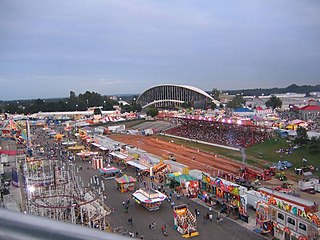
The North Carolina State Fair is an American state fair and agricultural exposition held annually in Raleigh, North Carolina. Founded in 1853, the fair is organized by the North Carolina Department of Agriculture and Consumer Services. It attracts around a million visitors over eleven days in mid-October.

The Oregon State Fair is the official state fair of the U.S. state of Oregon. It takes place every August–September at the 185-acre (0.75 km2) Oregon State Fairgrounds located in north Salem, the state capital, as it has almost every year since 1862. In 2006, responsibility for running the fair was delegated to the Oregon State Parks and Recreation Department, and the division is now known as the Oregon State Fair & Exposition Center (OSFEC), which holds events on the fairgrounds year-round.

The Big Fresno Fair, founded in 1884, is an annual fair held at the Fresno County Fairgrounds. The Big Fresno Fair is managed by the 21st District Agricultural Association, an entity of the California Department of Food and Agriculture Division of Fairs & Expositions. It is the largest annual event in the San Joaquin Valley, attracting around 600,000 people each October during its twelve-day run featuring exhibits, a livestock show, live horse racing, musical entertainment, educational programs and more. The Fair provides a link between urban and rural California, serving as a tool to educate visitors on the region's rich agricultural industry. The mission of The Big Fresno Fair is to "Educate, Celebrate and Have Fun".
The Arizona State Fairgrounds is a permanent fairgrounds on McDowell Road, Encanto Village, within the city of Phoenix, Arizona, United States. It is currently used yearly to host the Arizona State Fair and the Maricopa County Fair, as well as for other events.

Hemlock Fairground is a national historic district and fairground located at Hemlock in Livingston County, New York. The district covers 35.6 acres (144,000 m2) with five contributing buildings and one contributing object, the racetrack. There are two clusters of buildings near the racetrack. One cluster consists of the grandstand and livestock sheds located along the perimeter of the track at the southwest corner of the site. The second cluster consists of exhibition buildings located east of the track.
Lewis County Fairgrounds is a historic fairground and national historic district located at Lowville in Lewis County, New York. The district includes one contributing building and five contributing structures all constructed about 1876. They are the Grandstand, half-mile Race track, Antiques Building, Taffy Stand, Information Booth, and the balldiamond bleacher stands.
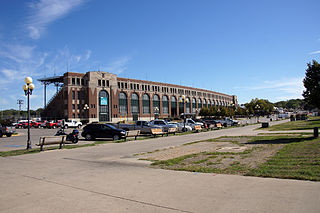
The Iowa State Fairgrounds is located on the east side of Des Moines, Iowa, United States. It annually hosts the Iowa State Fair in late summer. The state fair was begun in Iowa in 1854 and the current fairgrounds were established in 1886. The fairgrounds were listed as a historic district on the National Register of Historic Places in 1987 as the Iowa State Fair and Exposition Grounds.
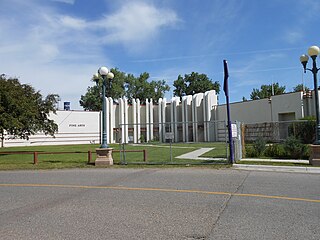
The Montana ExpoPark is a fairground located in the city of Great Falls, Montana, United States. The 133-acre (54 ha) grounds contain 35 buildings, a horse racing track, grandstands, and the Four Seasons Arena—multi-purpose sports and exhibition arena. The site is the host of the Montana State Fair as well as agricultural shows, rodeos, basketball tournaments, and funfairs. The six original structures of the fairgrounds were added to the National Register of Historic Places in 1989.
Missouri State Fair Speedway is a half-mile (.805 km) dirt oval race track located at the Missouri State Fair grounds in Sedalia, Missouri. The track was built along with the fairgrounds in 1901 as a one-mile (1.6-km) horse racing track. The first auto races were held in 1914 and 1915. Cars returned from 1935 until 1941, and again from 1946 until 1985 and 1989 until the mile was abandoned in 1998. One USAC National Championship race was held on the mile in 1970, won by Al Unser.

The Bridge near West Liberty is an historic structure located west of the town of West Liberty in rural Muscatine County, Iowa, United States. The welded steel rigid frame bridge was built in 1937. It was designed by Otto Wendling of the Iowa State Highway Commission. The bridge was listed on the National Register of Historic Places in 1998 as a part of the Highway Bridges of Iowa MPS. The bridge was demolished and replaced by a culvert in 2020.
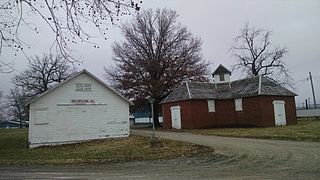
The Big 4 Fair Art Hall, also known as Hollenbeck Hall, is a historic building located in the Wapello County Fairgrounds in Eldon, Iowa, United States. The single-story brick structure was built in 1911, replacing an older building that had been destroyed in a fire. It is thought to be the oldest original brick building on a fairgrounds in the state. The building has four wings that were devoted to the four Iowa counties in the Big 4 Fair Association, Wapello, Davis (South), Jefferson (east), and Van Buren (southeast). People from each county would display their produce, grain, and arts and crafts in their county's wing. During other times of the year, the building was used for meetings and entertainment.

The Barnstable Fair Hall or Barnstable Agricultural Hall was an exhibition hall located in Barnstable, Massachusetts that was listed on the National Register of Historic Places on March 7, 1979. It was leveled by fire in the early morning of April 2, 1980. In the early 1990s, the structure was re-built as a condominium complex. In 1856 and 1857, land around the present building was given and sold to the Agricultural Society for use as a fairground. Total acreage of the property eventually exceeded twenty acres and extended as far back as the Maraspin Creek, a tidal stream. In 1857- 1858 a building "for exhibition purposes and a hall for public meetings" was built on the site of the present building. In February 1862, this first fair hall was destroyed by a gale, resulting in the formation of a building committee in April 1862 and the construction of the new structure between June 17 and October 14, 1862. Money for building costs came from private subscription, to which William Sturgis, a Boston merchant and native of Barnstable, was the major donor. Praised as being "superior in taste to the old" hall, the new Fair Hall was dedicated at the Barnstable County Fair of 1862 and served as the exhibition hall for all subsequent annual fairs until 1931 when the fair ceased to be held regularly. The fair is now held on an annual basis in Falmouth. During the period in which this property served as a fairground, there were additional shed and storage buildings to the north and east of the Fair Hall, as well as a track for trotting races, baseball diamond and grandstand, all of which have been removed. In addition to the usual exhibits of livestock and agricultural products, turn-of-the century fairs had vaudeville performances, balloonists, and other entertainments.
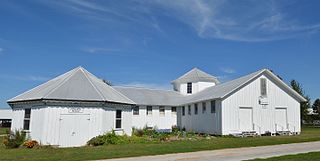
The Mercer County Fairgrounds, located on 12th Avenue SW in Aledo, are the home of the annual county fair in Mercer County, Illinois. The fairgrounds were established in 1869 when the fair moved to Aledo; from its creation in 1853 until then, it had taken place in Millersburg. The early fairs mainly focused on agricultural exhibitions, and the first two buildings were used for horticulture exhibits and household floral shows; these fairs also included entertainment such as baseball games and band concerts. By the end of the century, the fair had grown to host 8,000 visitors, many who came from neighboring counties by train, and show 3,000 entries in its various agricultural competitions. The fair added traveling entertainment and grew to host over 20,000 visitors in the 20th century; it is still held annually at the fairgrounds. In addition to the county fair, the fairgrounds have also held horse races, political events, picnics, and other community events.

Floral Hall is a historic building located at the Shelby County Fairgrounds in Harlan, Iowa, United States. It was listed on the National Register of Historic Places in 1985. The cross-shaped, frame structure is the oldest building on the fairgrounds, and one of the oldest, relatively unaltered, county fair exhibition buildings in Iowa. It is composed of four identical 18-by-18-foot sections organized around a 18-foot (5.5 m)-square central section, which is capped with a square cupola. Both the building and the cupola are capped with a gable roof. The exhibition hall was built by the Shelby County Agricultural Society, who organized the agricultural fair in 1869. They bought the present fairgrounds in 1879, and this building was built sometime between that year and 1882 to house exhibits that were of interest to women. Over the years it has housed a variety of exhibits. The Shelby County Fair Association took over the fair in 1891
The Montana State Fairgrounds Racetrack, also known as the Lewis and Clark County Fairgrounds Racetrack and as Helena Downs, is a historic horse racing track located on the outskirts of Helena, Montana, in the United States. Constructed in 1870, the track was part of the Montana State Fairgrounds, now the Lewis and Clark County Fairgrounds. The racetrack was added to the National Register of Historic Places on December 20, 2006. Portions of the track were demolished from 2006 to 2008 due to new construction on the fairgrounds.
Fred Maytag Park is a public park located in Newton, Iowa, United States. It was listed as a historic district on the National Register of Historic Places in 2010. At the time of its nomination it contained 39 resources, which included seven contributing buildings, nine contributing sites, eight contributing structures, four contributing objects, four non-contributing buildings, two non-contributing sites, three non-contributing structures, and two non-contributing objects. The park was a gift from F.L. Maytag, founder of the Maytag Company, to the people of Newton. It is significant as an example of a privately funded public park during the Great Depression. The 40-acre (16 ha) partial of land was acquired by Maytag in 1935. It had previously served as the fairgrounds owned by the Jasper County Agricultural Society. He made an agreement with the city council that the park would be privately owned and operated, but open for public use. The city was required to provide water and electricity. It remained a privately owned park until 1977 when it was conveyed to the city.

The Davenport Downtown Commercial Historic District is a nationally recognized historic district located in the central business district of Davenport, Iowa, United States. It was listed on the National Register of Historic Places in 2020. At the time of its nomination it consisted of 43 resources, which included 33 contributing buildings, one contributing structure, and nine non-contributing buildings. In addition, the district also contains 33 buildings that are individually listed on the National Register. This historic district is bordered by four other districts: the Crescent Warehouse Historic District and the Davenport Motor Row and Industrial Historic District on the east, the Hamburg Historic District to the northwest, and the West Third Street Historic District on the west.
The Butte–Lawrence County Fairgrounds are a historic fairground complex located near Nisland, South Dakota, United States. County fair celebrations for Butte and Lawrence Counties have been held there annually since 1921. The fairground and its buildings were listed on the National Register of Historic Places in 1986.

















